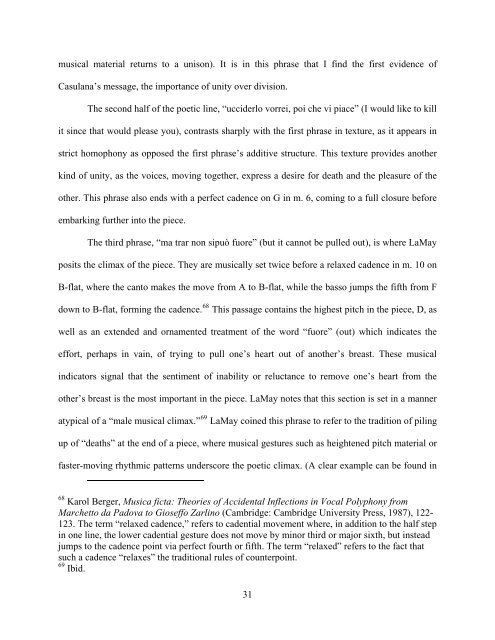Download - D-Scholarship@Pitt - University of Pittsburgh
Download - D-Scholarship@Pitt - University of Pittsburgh
Download - D-Scholarship@Pitt - University of Pittsburgh
Create successful ePaper yourself
Turn your PDF publications into a flip-book with our unique Google optimized e-Paper software.
musical material returns to a unison). It is in this phrase that I find the first evidence <strong>of</strong><br />
Casulana’s message, the importance <strong>of</strong> unity over division.<br />
The second half <strong>of</strong> the poetic line, “ucciderlo vorrei, poi che vi piace” (I would like to kill<br />
it since that would please you), contrasts sharply with the first phrase in texture, as it appears in<br />
strict homophony as opposed the first phrase’s additive structure. This texture provides another<br />
kind <strong>of</strong> unity, as the voices, moving together, express a desire for death and the pleasure <strong>of</strong> the<br />
other. This phrase also ends with a perfect cadence on G in m. 6, coming to a full closure before<br />
embarking further into the piece.<br />
The third phrase, “ma trar non sipuò fuore” (but it cannot be pulled out), is where LaMay<br />
posits the climax <strong>of</strong> the piece. They are musically set twice before a relaxed cadence in m. 10 on<br />
B-flat, where the canto makes the move from A to B-flat, while the basso jumps the fifth from F<br />
down to B-flat, forming the cadence. 68 This passage contains the highest pitch in the piece, D, as<br />
well as an extended and ornamented treatment <strong>of</strong> the word “fuore” (out) which indicates the<br />
effort, perhaps in vain, <strong>of</strong> trying to pull one’s heart out <strong>of</strong> another’s breast. These musical<br />
indicators signal that the sentiment <strong>of</strong> inability or reluctance to remove one’s heart from the<br />
other’s breast is the most important in the piece. LaMay notes that this section is set in a manner<br />
atypical <strong>of</strong> a “male musical climax.” 69 LaMay coined this phrase to refer to the tradition <strong>of</strong> piling<br />
up <strong>of</strong> “deaths” at the end <strong>of</strong> a piece, where musical gestures such as heightened pitch material or<br />
faster-moving rhythmic patterns underscore the poetic climax. (A clear example can be found in<br />
68 Karol Berger, Musica ficta: Theories <strong>of</strong> Accidental Inflections in Vocal Polyphony from<br />
Marchetto da Padova to Gioseffo Zarlino (Cambridge: Cambridge <strong>University</strong> Press, 1987), 122-<br />
123. The term “relaxed cadence,” refers to cadential movement where, in addition to the half step<br />
in one line, the lower cadential gesture does not move by minor third or major sixth, but instead<br />
jumps to the cadence point via perfect fourth or fifth. The term “relaxed” refers to the fact that<br />
such a cadence “relaxes” the traditional rules <strong>of</strong> counterpoint.<br />
69 Ibid.<br />
31















